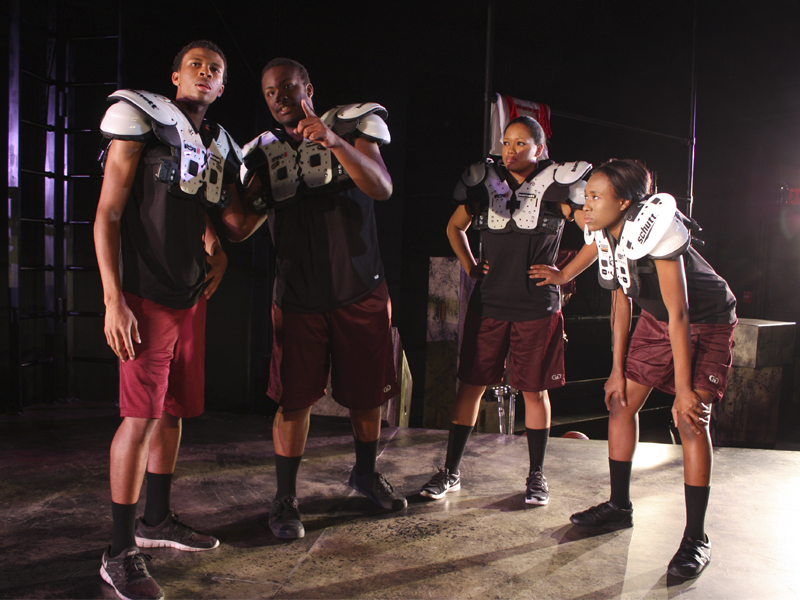
I can use any number of words to describe “Blackballin’.” A few of them might be: crazy, surreal, hallucinatory. But the word that truly captures the way in which this play gets its message across is simply this: different. The play uses American sports (football, baseball, basketball and boxing, to be specific) combined with fact-based research into how widespread discrimination was within each sport in the 20th century to offer the audience a bare and brutal look at racism in America.
Describing the plot is a chore in itself. Rather than viewing a straightforward narrative, I instead found myself looking at four different scenes that correspond with each sport and the athlete who plays it. The athletes are named Down, Stick, Hoop and Jab, and they each represent, respectively, football, baseball, basketball and boxing. Each scene occurs on each sport’s playing field, interchanged by the white character, Coach (Jack Koester), who plays a coach in the football and basketball scenes, and an umpire and referee in the baseball and boxing scenes. From being told that “you’re too good for your position” to being barraged with outright hateful language, the characters experience different forms of racial discrimination in their respective sports.
While the acting is high quality, the play’s writing is its main anchor. Rickerby Hinds, a professor of playwriting in the theater department at UCR, wrote the play in college in 1996 under the guise of what he describes as hip-hop theater. “I grew up listening to hip-hop back in the late ‘70s and ‘80s, when it was in its early stages of development as a genre of music,” he explained in an interview. “So for me, many of the elements of hip-hop, and how it can represent itself as black empowerment, was incorporated into my writing.”
One of the ways in which the play is so different from regular theater is that it uses the four individual experiences of the characters as a microcosm for real, historical racism in America’s past, and it totally works. We all know the stories of Jackie Robinson and Martin Luther King, Jr. Their singular stories of overcoming prejudice are a part of the collective American conscience, so what I love about the play is its radical way of addressing racism — not through the linear narratives of a story similar to that of Robinson or King, but rather using a group of nameless black athletes to represent the past through disconnected scenes of individualization.
“How does one truly begin to tell the story of how millions of African-Americans, for several, several years, were rejected from many aspects of society simply because of how they looked?” Hinds asked me. Each athlete experiences real prejudice within their own contexts — Down is withheld from the position of quarterback because he “runs too fast, jumps too high and throws too good”; Hoop learns that even though she’s one of the best athletes on her college basketball team, her chances of graduating are virtually zero; Stick is immediately given two strikes when he steps up to bat; and Jab is mocked for defeating her white opponents in the ring. Each moment in which these characters experience prejudice is horrifying, and Hinds uses these individuals to paint an encompassing picture of racism in the past. Without a simple, chapter-by-chapter narrative, it’s definitely a huge risk on the behalf of the playwright, but it works.
The play’s acting was as incredible as the story it tells onstage. Bryant Glover and Angelena Aguilera, who each play Stick and Jab, made their acting debuts at UCR with “Blackballin’,” while Kalif Gillett, who plays Down, and Kara Grimes, who plays Hoop, have numerous performances at UCR under their belts.
Bryant, a second-year business major, spoke with me about getting into character. “You really have to find out what makes a character click,” he said. “True emotions, and the ability to truthfully portray them in front of people, takes some getting used to because if you can’t get under the skin of your character, in a deeper sense, then you’ll never know how your character really feels about things, and their motivations for acting the way they act.”
Each character, which includes the four main leads as well as the white coach, is played with the dedication of a method actor, as the actors shout and stomp in adrenaline-fueled clamors within each scene. The result is a raw and vicious sentiment, a boiling anger, that one feels for the characters, restrained by the sadness over the realization of how real and truthful this piece of fiction is.
“Blackballin’” is almost too powerful and abstract to describe in words. The piece of art that playwright Rickerby Hinds has written presents itself as a thundering moral statement on the issue of racism and the past, as it leaves the audience trembling from a gaze not dulled by its own hypnotic vision.
Go watch it.
Rating: 5/5








